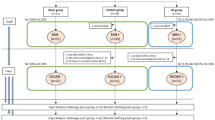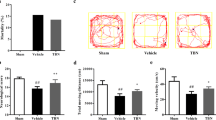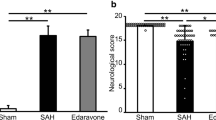Summary
Acute brain ischemia after subarachnoid hemorrhage (SAH) induces oxidative stress in brain tissues. Up-regulated NADPH oxidase (NOX), a major enzymatic source of superoxide anion in the brain, may contribute to early brain injury after SAH. We evaluated the effects of hyperbaric oxygen (HBO) on protein expression of gp91phox catalytic subunit of NOX, lipid peroxidation as a marker of oxidative stress, and on neurological and neuropathological outcomes after SAH.
Twenty-nine male Sprague-Dawley rats (300 to 350 g) were randomly allocated to control (sham operation), SAH (endovascular perforation), and SAH treated with HBO groups (2.8 ATA for 2 hours, at 1 hour after SAH). Cerebral blood flow was measured using laser Doppler flowmetry. Rats were sacrificed after 24 hours and brain tissues collected for histology (Nissl staining and gp91phox immunohistochemistry) and biochemistry. Mortality and neurological scores were evaluated.
Neuronal injury associated with enhanced gp91phox immunostaining was observed in the cerebral cortex after SAH. The lipid peroxidation product, malondialdehyde, accumulated in the ipsilateral cerebral cortex. HBO treatment reduced expression of NOX, diminished lipid peroxidation, and reduced neuronal damage. HBO caused a drop in mortality and ameliorated functional deficits.
HBO-induced neuroprotection after SAH may involve downregulation of NOX and a subsequent reduction in oxidative stress.
Access this chapter
Tax calculation will be finalised at checkout
Purchases are for personal use only
Preview
Unable to display preview. Download preview PDF.
Similar content being viewed by others
References
Arai T, Takeyama N, Tanaka T (1999) Glutathione monoethyl ester and inhibition of the oxyhemoglobin-induced increase in cytosolic calcium in cultured smooth-muscle cells. J Neurosurg 90: 527–532
Bederson JB, Germano IM, Guarino L (1995) Cortical blood flow and cerebral perfusion pressure in a new noncraniotomy model of subarachnoid hemorrhage in the rat. Stroke 26: 1086–1091
Benedetti S, Lamorgese A, Piersantelli M, Pagliarani S, Benvenuti F, Canestrari F (2004) Oxidative stress and antioxidant status in patients undergoing prolonged exposure to hyperbaric oxygen. Clin Biochem 37: 312–317
Chandel NS, McClintock DS, Feliciano CE, Wood TM, Melendez JA, Rodriguez AM, Schumacker PT (2000) Reactive oxygen species generated at mitochondrial complex III stabilize hypoxia-inducible factor-1alpha during hypoxia: a mechanism of O2 sensing. J Biol Chem 275: 25130–25138
Chavko M, Harabin AL (1996) Regional lipid peroxidation and protein oxidation in rat brain after hyperbaric oxygen exposure. Free Radic Biol Med 20: 973–978
Elayan IM, Axley MJ, Prasad PV, Ahlers ST, Auker CR (2000) Effect of hyperbaric oxygen treatment on nitric oxide and oxygen free radicals in rat brain. J Neurophysiol 83: 2022–2029
Gaetani P, Lombardi D (1992) Brain damage following subarachnoid hemorrhage: the imbalance between anti-oxidant systems and lipid peroxidative processes. J Neurosurg Sci 36: 1–10
Gaetani P, Pasqualin A, Baena R, Borasio E, Marzatico F (1998) Oxidative stress in the human brain after subarachnoid hemorrhage. J Neurosurg 89: 748–754
Garcia JH, Wagner S, Liu KF, Hu XJ (1995) Neurological deficit and extent of neuronal necrosis attributable to middle cerebral artery occlusion in rats. Statistical validation. Stroke 26: 627–634
Gleadle JM, Ebert BL, Ratcliffe PJ (1995) Diphenylene iodonium inhibits the induction of erythropoietin and other mammalian genes by hypoxia. Implications for the mechanism of oxygen sensing. Eur J Biochem 234: 92–99
Goyal P, Weissmann N, Grimminger F, Hegel C, Bader L, Rose F, Fink L, Ghofrani HA, Schermuly RT, Schmidt HH, Seeger W, Hanze J (2004) Upregulation of NAD(P)H oxidase 1 in hypoxia activates hypoxia-inducible factor 1 via increase in reactive oxygen species. Free Radic Biol Med 36: 1279–1288
Groger M, Speit G, Radermacher P, Muth CM (2005) Interaction of hyperbaric oxygen, nitric oxide, and heme oxygenase on DNA strand breaks in vivo. Mutat Res 572: 167–172
Grote E, Hassler W (1988) The critical first minutes after subarachnoid hemorrhage. Neurosurgery 22: 654–661
Helton R, Cui J, Scheel JR, Ellison JA, Ames C, Gibson C, Blouw B, Ouyang L, Dragatsis I, Zeitlin S, Johnson RS, Lipton SA, Barlow C (2005) Brain-specific knock-out of hypoxiainducible factor-1alpha reduces rather than increases hypoxicischemic damage. J Neurosci 25: 4099–4107
Ito T, Yufu K, Mori A, Packer L (1996) Oxidative stress alters arginine metabolism in rat brain: effect of sub-convulsive hyperbaric oxygen exposure. Neurochem Int 29: 187–195
Jarus-Dziedzic K, Czernicki Z, Kozniewska E (2003) Acute decrease of cerebrocortical microflow and lack of carbon dioxide reactivity following subarachnoid haemorrhage in the rat. Acta Neurochir [Suppl] 86: 473–476
Kim SH, Won SJ, Sohn S, Kwon HJ, Lee JY, Park JH, Gwag BJ (2002) Brain-derived neurotrophic factor can act as a pronecrotic factor through transcriptional and translational activation of NADPH oxidase. J Cell Biol 159: 821–831
Kocaogullar Y, Ustun ME, Avci E, Karabacakoglu A, Fossett D (2003) The role of hyperbaric oxygen in the management of subarachnoid hemorrhage. Intensive Care Med
Kot J, Sicko Z, Wozniak M (2003) Oxidative stress during oxygen tolerance test. Int Marit Health 54: 117–126
Kusaka G, Ishikawa M, Nanda A, Granger DN, Zhang JH (2004) Signaling pathways for early brain injury after subarachnoid hemorrhage. J Cereb Blood Flow Metab 24: 916–925
Kusaka I, Kusaka G, Zhou C, Ishikawa M, Nanda A, Granger DN, Zhang JH, Tang J (2004) Role of AT1 receptors and NAD(P)H oxidase in diabetes-aggravated ischemic brain injury. Am J Physiol Heart Circ Physiol 286: H2442–H2451
Lassegue B, Clempus RE (2003) Vascular NAD(P)H oxidases: specific features, expression, and regulation. Am J Physiol Regul Integr Comp Physiol 285: R277–R297
Lipton P (1999) Ischemic cell death in brain neurons. Physiol Rev 79: 1431–1568
Macdonald RL, Weir BK (1994) Cerebral vasospasm and free radicals. Free Radic Biol Med 16: 633–643
Marzatico F, Gaetani P, Baena R, Silvani V, Fulle I, Lombardi D, Ferlenga P, Benzi G (1989) Experimental subarachnoid hemorrhage. Lipid peroxidation and Na+,K(+)-ATPase in different rat brain areas. Mol Chem Neuropathol 11: 99–107
Marzatico F, Gaetani P, Cafe C, Spanu G, Baena R (1993) Antioxidant enzymatic activities after experimental subarachnoid hemorrhage in rats. Acta Neurol Scand 87: 62–66
Matz PG, Copin JC, Chan PH (2000) Cell death after exposure to subarachnoid hemolysate correlates inversely with expression of CuZn-superoxide dismutase. Stroke 31: 2450–2459
Matz PG, Fujimura M, Lewen A, Morita-Fujimura Y, Chan PH (2001) Increased cytochrome c-mediated DNA fragmentation and cell death in manganese-superoxide dismutase-deficient mice after exposure to subarachnoid hemolysate. Stroke 32: 506–515
Mink RB, Dutka AJ (1995) Hyperbaric oxygen after global cerebral ischemia in rabbits does not promote brain lipid peroxidation. Crit Care Med 23: 1398–1404
Mori T, Nagata K, Town T, Tan J, Matsui T, Asano T (2001) Intracisternal increase of superoxide anion production in a canine subarachnoid hemorrhage model. Stroke 32: 636–642
Mrsic-Pelcic J, Pelcic G, Vitezic D, Antoncic I, Filipovic T, Simonic A, Zupan G (2004) Hyperbaric oxygen treatment: the influence on the hippocampal superoxide dismutase and Na+,K+-ATPase activities in global cerebral ischemia-exposed rats. Neurochem Int 44: 585–594
Noda Y, McGeer PL, McGeer EG (1983) Lipid peroxide distribution in brain and the effect of hyperbaric oxygen. J Neurochem 40: 1329–1332
Ostrowski RP, Colohan AR, Zhang JH (2005) Mechanisms of hyperbaric oxygen-induced neuroprotection in a rat model of subarachnoid hemorrhage. J Cereb Blood Flow Metab 25: 554–571
Peng T, Lu X, Feng Q (2005) NADH oxidase signaling induces cyclooxygenase-2 expression during lipopolysaccharide stimulation in cardiomyocytes. FASEB J 19: 293–295
Prunell GF, Mathiesen T, Diemer NH, Svendgaard NA (2003) Experimental subarachnoid hemorrhage: subarachnoid blood volume, mortality rate, neuronal death, cerebral blood flow, and perfusion pressure in three different rat models. Neurosurgery 52: 165–175
Schwartz AY, Masago A, Sehba FA, Bederson JB (2000) Experimental models of subarachnoid hemorrhage in the rat: a refinement of the endovascular filament model. J Neurosci Meth 96: 161–167
Serrano F, Kolluri NS, Wientjes FB, Card JP, Klann E (2003) NADPH oxidase immunoreactivity in the mouse brain. Brain Res 988: 193–198
Shin HK, Lee JH, Kim KY, Kim CD, Lee WS, Rhim BY, Hong KW (2002) Impairment of autoregulatory vasodilation by NAD(P)H oxidase-dependent superoxide generation during acute stage of subarachnoid hemorrhage in rat pial artery. J Cereb Blood Flow Metab 22: 869–877
Tammariello SP, Quinn MT, Estus S (2000) NADPH oxidase contributes directly to oxidative stress and apoptosis in nerve growth factor-deprived sympathetic neurons. J Neurosci 20: RC53
Turner CP, Panter SS, Sharp FR (1999) Anti-oxidants prevent focal rat brain injury as assessed by induction of heat shock proteins (HSP70, HO-1/HSP32, HSP47) following subarachnoid injections of lysed blood. Brain Res Mol Brain Res 65: 87–102
Vallet P, Charnay Y, Steger K, Ogier-Denis E, Kovari E, Herrmann F, Michel JP, Szanto I (2005) Neuronal expression of the NADPH oxidase NOX4, and its regulation in mouse experimental brain ischemia. Neuroscience 132: 233–238
Vignais PV (2002) The superoxide-generating NADPH oxidase: structural aspects and activation mechanism. Cell Mol Life Sci 59: 1428–1459
Yin W, Badr AE, Mychaskiw G, Zhang JH (2002) Down regulation of COX-2 is involved in hyperbaric oxygen treatment in a rat transient focal cerebral ischemia model. Brain Res 926: 165–171
Zaleska MM, Floyd RA (1985) Regional lipid peroxidation in rat brain in vitro: possible role of endogenous iron. Neurochem Res 10: 397–410
Zhang X, Dong F, Ren J, Driscoll MJ, Culver B (2005) High dietary fat induces NADPH oxidase-associated oxidative stress and inflammation in rat cerebral cortex. Exp Neurol 191: 318–325
Zheng JS, Zhan RY, Zheng SS, Zhou YQ, Tong Y, Wan S (2005) Inhibition of NADPH oxidase attenuates vasospasm after experimental subarachnoid hemorrhage in rats. Stroke 36: 1059–1064
Author information
Authors and Affiliations
Editor information
Editors and Affiliations
Rights and permissions
Copyright information
© 2006 Springer-Verlag
About this paper
Cite this paper
Ostrowski, R.P., Colohan, A.R.T., Zhang, J.H. (2006). Neuroprotective effect of hyperbaric oxygen in a rat model of subarachnoid hemorrhage. In: Hoff, J.T., Keep, R.F., Xi, G., Hua, Y. (eds) Brain Edema XIII. Acta Neurochirurgica Supplementum, vol 96. Springer, Vienna. https://doi.org/10.1007/3-211-30714-1_41
Download citation
DOI: https://doi.org/10.1007/3-211-30714-1_41
Publisher Name: Springer, Vienna
Print ISBN: 978-3-211-30712-0
Online ISBN: 978-3-211-30714-4
eBook Packages: MedicineMedicine (R0)




